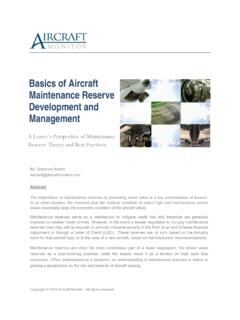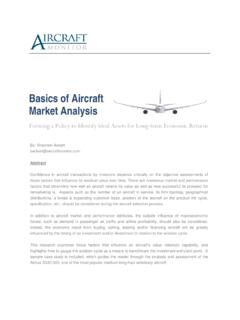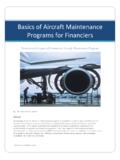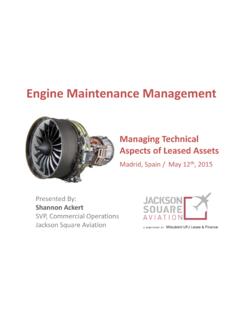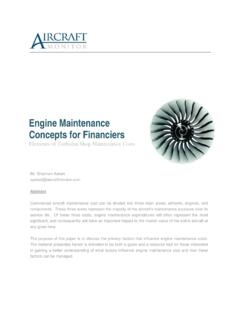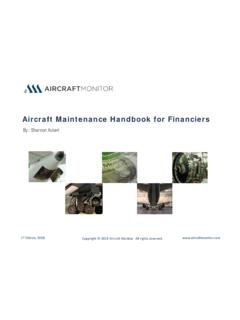Transcription of Commercial Aspects of Aircraft Customization V1
1 By: Shannon Ackert Abstract Aircraft manufacturers provide the flexibility for their airline customers to customize a wide variety of airplane features needed to properly differentiate individual brands and to satisy operational requirements. Beginning with a standard specification, airlines then modify or add among a wide variety of pre-qualified selections available from a large pool of industry-leading suppliers.
2 This report provides an introduction to the Aircraft Customization process by examining how airlines choose among the enormous number of selectable options available, primarily in the form of Seller- Furnished equipment (SFE) and Buyer-Furnished equipment (BFE). An analysis of the economics associated with the Customization process is also discussed and quantified. Lastly, the research highlights why & how the major manufacturers are forgoing a traditional BFE approach and advancing the industry into a new era with increased standardization and fewer options.
3 Commercial Aspects of Aircraft Customization Copyright 2013 Aircraft Monitor. All rights reserved. 1 Version / November 2013 | Aircraft Monitor Commercial Aspects of Aircraft Customization TABLE OF CONTENTS 1. INTRODUCTION .. 2 2. Aircraft SELECTABLE 3 Independent 3 Supplier-Furnished equipment (SFE).. 3 Buyer-Furnished equipment (BFE).. 4 Package 7 3. Aircraft Customization 8 Customization and Aircraft Price 10 Customization 11 4.
4 Aircraft Customization & PRICE BUILD-UP .. 11 Changing the MZFW limit .. 11 5. Aircraft Customization MILESTONES .. 11 6. THE FUTURE OF Aircraft Customization .. 12 Aircraft Manufacturer Example Standardization 14 APPENDIX A EXAMPLE CABIN equipment FURNISHING 15 REFERENCES .. 16 Aircraft Monitor | Version / November 2013 2 Commercial Aspects of Aircraft Customization 1. INTRODUCTION Airframers facilitate the Aircraft Customization process by enabling airlines to select among a wide variety of optional equipment , ranging from the type of engines used to a wide variety of cabin interior offerings.
5 This flexibility allows airlines to incorporate popular features needed to differentiate their individual brands as well as satisfy particular operational requirements see example in Figure 1 below. Branding establishes an airline s distinctive identity. In particular, it is the cabin architecture that creates the strongest impression, and generally frames passenger emotions and expectations for their flight experience. For example, today many airliners emphasize cabin designs that offer passengers more options for work and leisure while airborne through more space and premium seats, dynamic lighting, in-flight connectivity, and entertainment systems.
6 Such amenities give airlines the flexibility to differentiate services and the airline brand. Airlines also have the option to purchase a large number of operational equipment direct from competing suppliers. For example, many of the communication and navigation systems are defined by industry standards ( ARINC characteristics) and offered by suppliers such as Honeywell and Rockwell-Collins. An airline will usually select a supplier for their entire fleet and then have the supplier adapt it to the particular airplane installation.
7 With this standardization, the airline is also able to obtain spares from the vendor or other airlines at locations where he does not have a spares depot. FIGURE 1 EXAMPLE Customization REQUIREMENTS 3 Version / November 2013 | Aircraft Monitor Commercial Aspects of Aircraft Customization 2. Aircraft SELECTABLE FEATURES Today, airliners can choose from among a wide range of selectable features that provide value to their operation. Optional provisions such as satellite communications for long-range overwater operation, In-Flight Entertainment (IFE) systems, and premium seats, give airlines the ability to improve passenger experience and enhance operating efficiencies.
8 Selectable features are generally made up of independent selections and package selections, which are discussed in greater detail below. Independent Selections Independent selectable features are pre-qualified equipment options offered from wide variety of industry-leading suppliers. The options offered are used to modify or add to the standard features described in the Aircraft s baseline specification. Independent selections are made up of selectable Seller- Furnished equipment (SFE), which is optional equipment offered directly by the Aircraft manufacturer, and Buyer-Furnished equipment (BFE), which is optional equipment which the airlines choose during the production of the Aircraft , and which the airline is fully responsible for negotiating directly with the OEM for all terms of the purchase.
9 Another category used is Seller Purchased equipment (SPE), which is simply (BFE) that the Aircraft manufacturer purchases on behalf of the customer. Supplier Furnished equipment (SFE) SFE is standard equipment which makes up the bulk of the hardware installed on an Aircraft . SFE is generally sole-sourced to suppliers under a partnership/cost-sharing agreement and includes equipment used in avionics, hydraulic, electrical, environmental, and fuel systems.
10 Generally, there are limited SFE options for the operator to choose from, and when available they are commercially managed between airline and the Aircraft manufacturer. The price of all SFE is commonly included in the airframe price. SFE suppliers are generally not required to bid for contracts at each phase of the design and manufacturing process, but are expected to be highly responsive to the needs of the manufacturer as part of a longer term partnership. This strategy reassures equipment suppliers of the manufacturer s commitment, avoids costs associated with frequent re-competitions, and puts SFE suppliers in a position to influence the establishment of future industry standards and specifications for new equipment .
